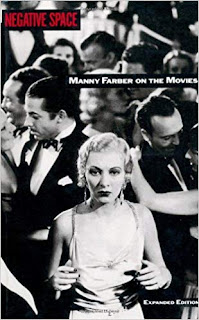"Negative Space: Manny Farber on the Movies", Manny Farber
Manny
Farber (1917–2008) was a painter and film critic, regularly contributing to
publications such as The New Republic, The Nation, Artforum, Film Culture, and
others. He was distinguished by its inventive, iconoclastic writing, and for
being a defender of action– Howard Hawks, Samuel Fuller, William Wellman, Raoul
Walsh, Anthony Mann – and underground filmmakers, like Michael Snow and Andy
Warhol. One of his most remembered essays is "White Elephant Art vs.
Termite Art", in which he writes about the virtues of "termite
art", the excesses of "white elephant art", by championing the
first, “where the spotlight of culture is nowhere in evidence, so that the craftsman
can be ornery, wasteful, stubbornly self-involved, doing go-for-broke art and
not caring what comes of it”, against the second, that treats “every inch of
the screen and film as a potential area for prizeworthy creativity” and lacks
the economy of expression of “termite art”. Negative Space: Manny Farber on the Movies gathers Farber's most influential writings.
Excerpts
“The
saddest thing in current films is watching the long-neglected action directors
fade away as the less talented De Sicas and Zinnemanns continue to fascinate
the critics. Because they played an anti-art role in Hollywood, the true masters
of the male action film—such soldier-cowboy-gangster directors as Raoul Walsh,
Howard Hawks, William Wellman, William Keighley, the early, pre-Stagecoach John
Ford, Anthony Mann—have turned out a huge amount of unprized, second-gear
celluloid. Their neglect becomes more painful to behold now that the action
directors are in decline, many of them having abandoned the dry, economic,
life-worn movie style that made their observations of the American he-man so
rewarding. Americans seem to have a special aptitude for allowing History to
bury the toughest, most authentic native talents.” from Underground Films.
“Fuller is
one of the first to try for poetic purity through a merging of unlimited
sadism, done candidly and close up, with stretches of pastoral nostalgia in
which there are flickers of myth.” in Samuel
Fuller.
“Movies
have always been suspiciously addicted to termite-art tendencies. Good work
usually arises where the creators (Laurel and Hardy, the team of Howard Hawks
and William Faulkner operating on the first half of Raymond Chandler’s The Big
Sleep) seem to have no ambitions towards gilt culture but are involved in a
kind of squandering-beaverish endeavor that isn’t anywhere or for anything. A
peculiar fact about termite-tapeworm-fungus-moss art is that it goes always
forward eating its own boundaries, and, likely as not, leaves nothing in its
path other than the signs of eager, industrious, unkempt activity.” from White Elephant Art vs. Termite Art
Link to the complete book in PDF




Comments
Post a Comment